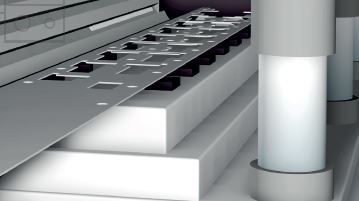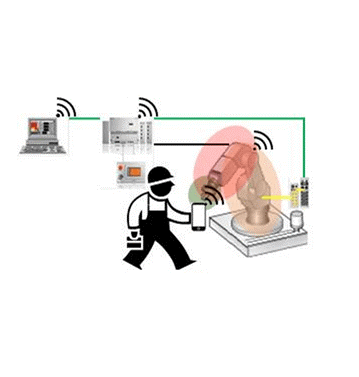Washing machines, dryers, refrigerators and other large household appliances are manufactured in complex, highly automated manufacturing processes. These processes include issues such as robotics, traceability, smart manufacturing, IIoT, condition monitoring, automated quality control and more.
You will find interesting articles on many of these topics here on this blog, such as: Sensor-based monitoring of punching machines, or More transparency in production.
The key to producing high-quality products and avoiding unnecessary customer complaints is precision in component manufacturing as well as in final assembly. Therefore, one of many reasons to automate a manufacturing operation is to avoid errors that can result from inaccurate manual labor. In a predominantly manual production and assembly process, individual process steps can also be automated – for example, monotonous activities such as visual quality control of the correct assembly of drive belts in washing machine production.
The task
The drive belts of washing machines are mounted manually during the manufacturing process. Inaccurate installation can result in the belt slipping off the drive wheel after a short period of use by the end customer. This, in turn leads to customer complaints. To avoid this quality defect, the correct installation of the drive belt is checked on all washing machines. This repetitive work is often carried out by an employee. However, this has two major disadvantages: First, a valuable resource is used inefficiently, and second, the possibility of the error still exists. The reasons for faulty assembly are many and varied, for example declining concentration or carelessness.
Automated quality control using a machine vision system offers an effective alternative.

The solution
For the application described here, Balluff components offer a simple and effective solution.
For example, a device containing an adapted system with Machine Vision components can reliably check the correct installation of drive belts in washing machines.
Limited space in the inspection station and the resulting difficulties in installing and aligning the camera system can be easily circumvented. An angled mirror with a prism, which is positioned in front of the camera lens, makes it much easier to position the system (Figure 2). Thus, the complete camera does not have to be in the washing machine, but only the mirror element. In order for the washing machine to enter the inspection station, the entire camera system is mounted on a linear module. This moves into the washing machine after it arrives at its final position in the inspection station (Figure 3).
This solution enables measurements with an accuracy of 0.02 mm.


Since the drive wheel rotates while the washing machine is in use, the position of the drive belt may change, and a faulty installation may only become visible afterwards. To simulate this, the wheel is set in motion during the inspection and several measurements of the drive belt are taken. A second camera monitors the angular position of the drive wheel and thus whether the drive is in motion (Figure 4). Depending on the cycle time of the inspection station, any number of measurements of the washing machine (in simulated use) can be carried out. The correct installation of the drive belt can therefore be checked reliably and without errors.

Further examples of how Balluff supports the production of household appliances can be found in our industry brochure (LINK).






